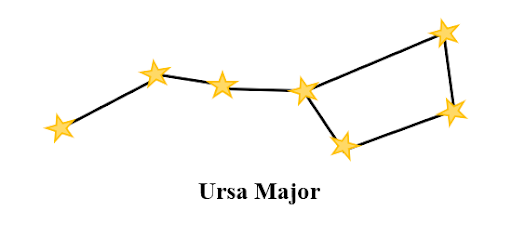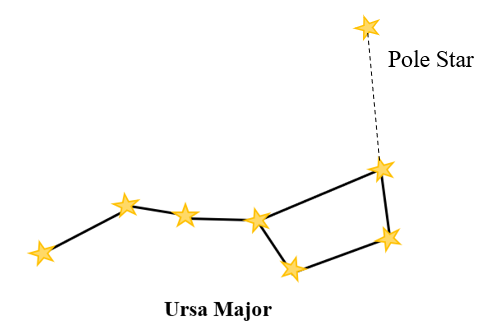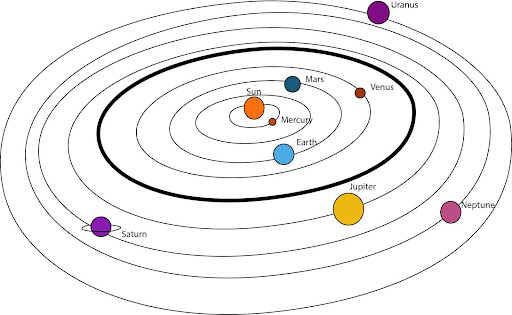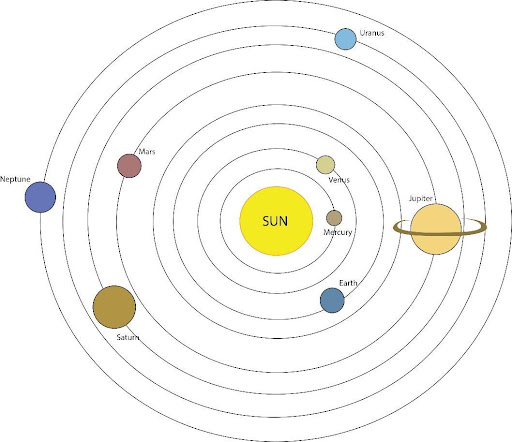Stars And The Solar System Class 8 Questions and Answers - Free PDF Download
FAQs on NCERT Solutions For Class 8 Science Chapter 17 Stars And The Solar System - 2025-26
1. How do you solve the problem calculating the ratio of Jupiter's volume to Earth's in NCERT Class 8 Science Chapter 17?
To solve this, you must follow the correct method as per the CBSE 2025-26 syllabus. First, understand that both planets are considered spheres. The solution involves these steps:
- State the formula for the volume of a sphere: V = (4/3)πr³.
- Use the given information: Jupiter's radius (Rj) is 11 times Earth's radius (Re), so Rj = 11 * Re.
- Write the volumes for both planets: V(Jupiter) = (4/3)π(11Re)³ and V(Earth) = (4/3)πRe³.
- Calculate the ratio V(Jupiter)/V(Earth). The term (4/3)πRe³ cancels out, leaving you with 11³.
- The final ratio is 1331:1, meaning Jupiter can accommodate 1331 Earths.
2. What is the correct method to locate the Pole Star using Ursa Major, as explained in the NCERT textbook?
The correct procedure described in the NCERT solutions for finding the Pole Star involves using the Ursa Major constellation, also known as the Saptarishi or Big Dipper. Imagine a straight line connecting the last two stars at the end of Ursa Major's bowl. If you extend this imaginary line towards the North direction, it will point directly to a bright star that is not very bright. This star is the Pole Star or Dhruva Tara.
3. According to the NCERT solutions, what are the key corrections for the incorrect diagram of the solar system in the textbook exercise?
The provided sketch in the NCERT exercise has several errors. The correct solution requires making the following adjustments to the planetary positions:
- The positions of Venus and Mars must be interchanged. The correct order from the Sun is Mercury, Venus, Earth, Mars.
- The positions of Uranus and Neptune must also be swapped. The correct order is Jupiter, Saturn, Uranus, Neptune.
- The asteroid belt is incorrectly placed. It should be located in the large gap between the orbits of Mars and Jupiter.
4. Why do the phases of the moon occur? How does the NCERT solution explain this phenomenon?
The phases of the moon occur because the moon does not produce its own light. It is a non-luminous body that only reflects sunlight. From Earth, we can only see the part of the moon's surface that is illuminated by the Sun and facing us. As the moon revolves around the Earth, the portion of its sunlit side that is visible to us changes continuously, creating the different phases like the crescent moon, half-moon, and full moon.
5. Why is the distance between stars expressed in light-years and not kilometres?
The distance between stars and other celestial objects is enormous. Using kilometres to measure these vast distances would result in extremely large and inconvenient numbers. Therefore, a much larger and more practical unit, the light-year, is used. A light-year is the total distance that light travels in one year. This unit simplifies calculations and makes it easier to comprehend the immense scale of the universe.
6. Do all the stars in the sky move? Why does the Pole Star appear stationary?
While it appears that stars move from east to west across the sky, this is actually due to the rotation of the Earth on its axis. The stars themselves are relatively fixed in their positions over human lifespans. The Pole Star, however, appears stationary because it is located directly above the Earth's axis of rotation in the northern hemisphere. As the Earth spins, the Pole Star remains in the same spot in the sky, while all other stars appear to revolve around it.
7. What is the fundamental difference between an asteroid and a comet as described in Chapter 17?
The NCERT solutions clarify the key differences. Asteroids are small, rocky, and metallic objects that orbit the Sun, mostly found in the asteroid belt between Mars and Jupiter. They do not have tails. Comets, on the other hand, are made of ice, dust, and rock. As they approach the Sun, the ice vaporises, creating a glowing head (coma) and a long, glowing tail that always points away from the Sun.
8. How does the NCERT solution define a constellation, and which two examples are given as easily recognisable?
A constellation is defined as a group of stars that appear to form a recognisable pattern or shape in the night sky. These patterns have been identified and named by ancient civilisations. The NCERT solutions highlight two major constellations visible from the Northern Hemisphere:
- Ursa Major: Also known as the Great Bear or Saptarishi, it looks like a big ladle or question mark. It is visible in the summer.
- Orion: Also known as the Hunter, it is visible during the winter. It has several bright stars, with three in the middle forming the 'belt'.
9. What is the correct answer for 'Shooting stars are actually not _________' in the fill-in-the-blanks exercise?
The correct answer for the NCERT exercise is that shooting stars are actually not stars. 'Shooting stars' is the common name for meteors. These are small pieces of rock or debris that enter the Earth's atmosphere at very high speed. They burn up due to friction with the air, creating a bright streak of light across the sky.
10. What distinguishes an artificial satellite like INSAT from a natural satellite like the Moon?
The key distinction is their origin. A natural satellite, like the Moon, is a celestial body that naturally orbits a planet. An artificial satellite, like INSAT (Indian National Satellite System), is a man-made object launched into orbit to perform specific tasks such as telecommunication, weather forecasting, and remote sensing. While both revolve around a planet, one is natural and the other is engineered and placed in orbit by humans.




















